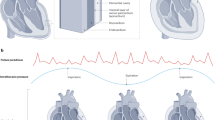Abstract
Three cases of pericardial tamponade caused by central venous catheters are reported. Two essential factors have been recognized. First, the catheter material should be extremely soft and remain soft. Today the best material available seems to be a silicone rubber elastomer. Polyvinylchloride or polyethylene, which is widely used, is too rigid. These materials also contain phthalate esters to soften the plastic, and these softeners are gradually washed out into the bloodstream, rendering the catheters even more rigid in time. Second, a central venous catheter should enter the venous system proximal to the shoulder. When the catheter is inserted through a vein in the arm, the tip of the catheter will be able to progress 6–10 cm farther down in the venous system by extreme movements of the arm. This occurs regularly when a patient is turned in bed and his or her arm is elevated 108‡ at the shoulder. The internal jugular vein and the subclavian vein are the most suitable veins for catheterization. Veins in the arm should not be used.
Résumé
Trois cas de “tamponade” péricardique après cathétérisme veineux central sont rapportés cependant que deux causes particulières de ce type d'accident iatrogène ont été mises en évidence:-emploi d'un catheter rigide.-lieu inadéquat d'introduction de cet élément. En fait, le catheter doit Être souple et le rester, le meilleur matériaux étant représenté par le silicone. Le catheter en polyethylene largement employé est trop rigide, il contient également des éléments chimiques qui ont pour but de l'assouplir mais qui sont éliminés progressivement dans le sang.
D'autre part le catheter doit Être introduit dans le système veineux a proximité de l'épaule. Quand il est mis en place au niveau du bras il peut progresser de 6 à 10 cm dans le système veineux sous l'impulsion des mouvements du membre supérieur. Ceci survient régulièrement quand le malade est retourné dans son lit et que le membre est ainsi levé à 180‡. La veine jugulaire interne ou la veine sous clavière représentent le meilleur lieu d'introduction du cath éter. Il ne faut jamais le mettre en place au niveau d'une veine brachiale.
Similar content being viewed by others
References
Greenall, M.J., Blewitt, R.W., McMahon, M.J.: Cardiac tamponade and central venous catheters. Br. Med. J.2:595, 1975
Iglesias, A., Maronas, J.M., Rufilanchas, J.J., Figuera, D.: Perforation of the right ventricle and cardiac tamponade caused by a venous catheter. Postgrad. Med. J.53:225, 1977
Migliori, G., Michelangeli, F., Codinach, F., Blaive, B.: Perforations cardiaques par catheter veineux central. Nouv. Presse Méd.5:987, 1976
Thomas, C.S., Jr., Carter, J.W., Lowder, S.C.: Pericardial tamponade from central venous catheters. Arch. Surg.98:217, 1969
Brandt, R.L., Foley, W.J., Fink, G.H., Regan, W.J.: Mechanism of perforation of the heart with production of hydropericardium by a venous catheter and its prevention. Am. J. Surg.119:311, 1970
Göthman, B., Wallensten, S., Wickbom, G.: Tre fall av mekaniska komplikationer jÄmte PM för metodik vid intravenös infusion. LÄkartidningen68:3301, 1971
Brown, C.A., Kent, A.: Perforation of right ventricle by polyethylene catheter. South. Med. J.49:466, 1956
Johnson, C.E.: Perforation of right atrium by a polyethylene catheter. J.A.M.A.195:176, 1966
Barton, J.J., Vanecko, R., Gross, M.: Perforation of right atrium and resultant cardiac tamponade: A complication of catheterization to measure central venous pressure. Obstet. Gynecol.32:556, 1968
Kline, I.K., Hofman, W.I.: Cardiac tamponade from CVP catheter perforation. J.A.M.A.206:1794, 1968
Defalque, R.J.: Fatal complication of subclavian catheter. Can. Anaesth. Soc. J.18:681, 1971
Adar, R., Mozes, M.: Fatal complications of central venous catheters. Br. Med. J.3:746, 1971
Henzel, J.H., De Weese, M.S.: Morbid and mortal complications associated with prolonged central venous cannulation. Am. J. Surg.121:600, 1971
Colvin, M.M., Savege, T.M., Blogg, C.E., Jarvis, J.D., Strunin, L.: A safe long-term infusion technique? Lancet2:317, 1972
Bethel, H.J.N.: Long-term intravenous infusions. Lancet2:433, 1972
Bell, J.A., Bradley, R.D., Jenkins, B.S.: Malpositioning of central venous catheters. Lancet1:105, 1973
Solassol, C., Joyeux, H.: Nouvelles techniques pour nutrition parentérale chronique. Arq. Gastroent. S. Paulo12:41, 1975
Normand, M., Joyeux, H., Cayotte, J.-L., Chouraqui, D.: Cathétérisme de la veine jugulaire interne pour nutrition parentérale. Nouv. Presse Méd.46:4225, 1978
Author information
Authors and Affiliations
Rights and permissions
About this article
Cite this article
Krog, M., Berggren, L., Brodin, M. et al. Pericardial tamponade caused by central venous catheters. World J. Surg. 6, 138–142 (1982). https://doi.org/10.1007/BF01656389
Issue Date:
DOI: https://doi.org/10.1007/BF01656389




